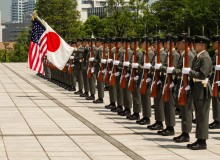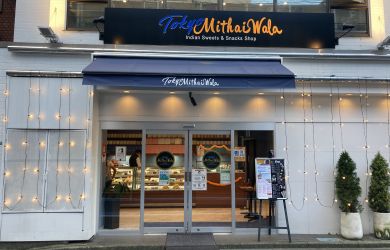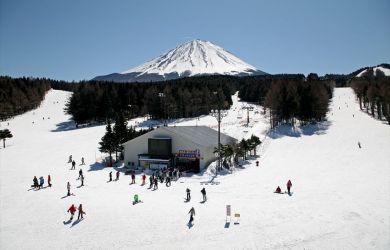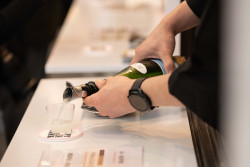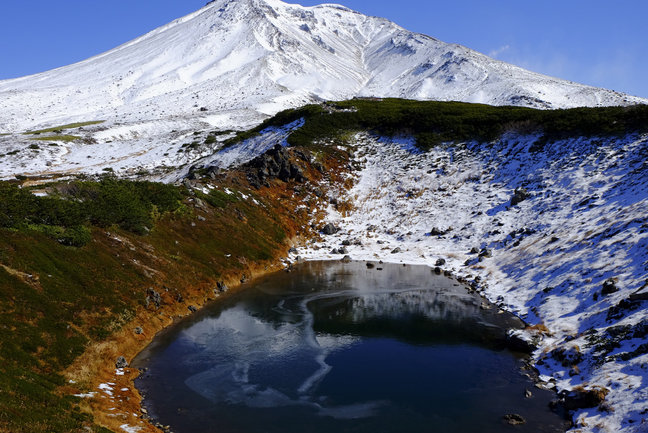
December 13, 2022
A Journey With a Gun and No Money
Bunsho Hattori and Ryuichi Ishikawa
On October 9, 2021, Bunsho Hattori and Ryuichi Ishikawa set out on a journey. Arriving in Kikonai, a tiny village with a population of 4,000 on the gray, desolate coast of Hokkaido, the professional mountaineer and photographer duo left their money and cell phones behind. They armed themselves with hunting rifles, a small amount of rice, and Hattori’s trusty canine companion. Then, they embarked on a journey into the Hokkaido wilderness.
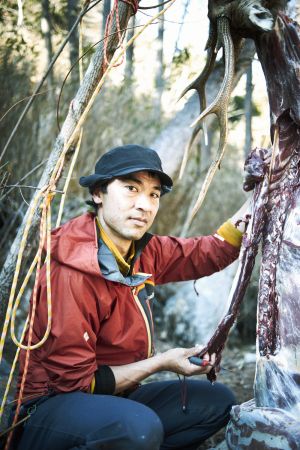
“Mountaineering is a form of art like dancing, where the mountains are your stage,” says Hattori. For the large-scale art festival Aichi Triennale, which took place this past summer, Hattori and Ishikawa decided to make an exhibit out of a journey to prove this bold statement.
After making their way down to Cape Shirakami, the southernmost tip of Hokkaido, they turned north, ascending high into the mountains through scarcely trekked territory: Mt. Daisengen, Mt. Kariba, Mt. Oshamanbedake. This isn’t Hakone or ski country—it’s wild territory, as the two survived by procuring food with their guns and their own hands and sweat.
While surviving for two months in the wilderness is impressive to the majority of us who are town-bound, the resulting exhibit wasn’t flashy. Their installation of deer skulls and hides, photographs, text, audio recordings, and gathered stones in a former Tokoname pipe factory is a quiet monument to a way of living that is deeply natural to homo sapiens, and yet incredibly foreign to our current way of life. But the exhibit speaks volumes both about the purpose of art and the meaning of nature in a hyper-developed Japanese society.
Hattori, 53, started climbing mountains in a club at university and fell in love with it. After graduating, he found a job at a hiking magazine and started writing articles about mountaineering. But his career really took off after he climbed Pakistan’s K2 with a Japanese expedition. Before long, he decided to not just ascend peaks, but to leave behind the heavy packs and gear and embark on a new kind of mountaineering: journeys across Japan’s lengthy mountainous ridges, procuring sustenance, water, and fuel from nature along the way.

“I’ve been hiking this way for about twenty years now,” says Hattori. “I used to think that food was something from supermarkets, something that you paid for with money. But now I recognize that food is something that you get from nature. You need to take in life in order to sustain your own life. For better or worse, food and life are equivalent—we live on this Earth alongside our food.”
His latest book, Okane ni Tayorazu Ikitai Kimi e (“To You, Who Wants to Live Without Relying on Money”) documents his experience living in an abandoned village in the mountains. In fact, that’s where Hattori was when I did an interview with him on Zoom for this article, living in a one hundred year old home. And of course, procuring food, fuel, and water on his own. “I want to try to show that people can enjoy life while living this way,” he says.
Ryuichi Ishikawa’s colorful Okinawan portrait series and his photographs of the beautiful and grotesque that can be found in nature have been widely featured in galleries across Japan. But Ishikawa didn’t have any experience mountaineering until he was introduced to Hattori and they went on an exhibition together in 2015.

“I fell in the snow and almost died,” Ishikawa said. “It’s really dangerous—you’re risking your life out there. At first, I swore to never do it again.” But after reflecting on why he didn’t enjoy the experience, he resolved to give it a second try and started to go into the mountains a few times a year with Hattori. In the course of these trips, Ishikawa realized that his fear was coming from the core truth that life simply isn’t precious out in the wilderness.
“You kill and eat animals, which are living beings just like you. Life dies easily out there, and by experiencing the mountains, you grow closer to death,” Ishikawa says. “Back in cities, we’re inundated with the idea that life is a priceless treasure. But in nature, you’re like the other plants and animals.”
Surprisingly, the most striking part of the exhibition is not Ishikawa’s photographs, but his audio recordings from the journey—the sounds of rivers, rain, boar, birds, and his own body. “I found it fascinating that the sounds of nature were similar to those coming from my body,” Ishikawa said. “That connection was probably the deepest revelation of the trip.”
While Ishikawa didn’t almost die in Hokkaido this time, the pair did have to cross a bridge without a floor—soaring 50+ meters over a surging river below. The heavy snowfall had wiped out all of the wooden floorboards from the bridge. “If we made one tiny mistake, we’d instantly die,” he said. “My heart was racing.”
Ultimately for Hattori, the power of wilderness comes down to freedom. Namely, the type of freedom you can only truly feel when deep in the mountains. “To walk to the very limit of your own stamina is to enter the realm of true freedom,” Hattori says. “You feel freedom when you encounter your own physical limits. I think living in town is much more twisted than the way of living in the wilderness.”

While he’s a strong advocate for the preservation of Japan’s vast forested mountains, Hattori is also practical. “There’s no point in creating nature that’s impossible for people to access,” he says. “Humans need to walk through the wilderness with their own feet. I want to see national parks that are fair for both nature and humans, where humans can enter nature, but only as pure humans [without technology].”

Hattori and Ishikawa’s exhibit at the Aichi Triennale comes at a time when many young and upcoming artists across Japan are developing exciting artistic practices that celebrate the wild depths of nature. These are depths that have the power to create more new (old) ways of living, and in many ways, represent a more genuine way of life.
“It can’t be just designed, manicured green,” says Ishikawa. “We all need chances to truly interact with nature.”
